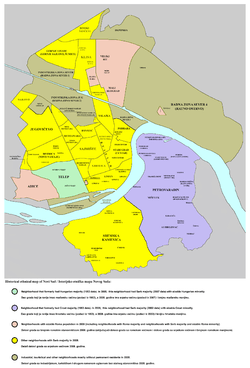Demographic history of Novi Sad
| Year | Population | |||
|---|---|---|---|---|
| 1798 | 6,890 | |||
| 1843 | 17,332 | |||
| 1850 | 7,182 | |||
| 1869 | 19,119 | |||
| 1880 | 21,325 | |||
| 1890 | 24,717 | |||
| 1900 | 28,763 | |||
| 1910 | 33,089 | |||
| 1921 | 39,122 | |||
| 1931 | 63,985 | |||
| 1941 | 61,731 | |||
| 1948 | 69,431 | |||
| 1953 | 76,752 | |||
| 1961 | 102,469 | |||
| 1971 | 141,375 | |||
| 1981 | 170,020 | |||
| 1991 | 198,326a | |||
| 2002 | 216,583a | |||
| 2011 | 277,522a | |||
| a including Petrovaradin and Sremska Kamenica | ||||

This is demographic history of Novi Sad.
Ottoman rule
During the Ottoman rule, Petrovaradin had 200 (mostly Muslim) houses. There was also a Christian quarter with 35 houses populated by ethnic Serbs.[1] In the year 1590, population of all villages that existed in the territory of present-day Novi Sad (on the left bank of the Danube) numbered 105 houses inhabited exclusively by Serbs. However, Ottoman records mention only those inhabitants that paid taxes, thus the number of Serbs that lived in the area (for example those that served in the Ottoman army) was larger.[2]
Habsburg rule
1720
According to 1720 data, the population of Ratzen Stadt (later known as Novi Sad) was composed of 112 Serbian, 14 German, and 5 Hungarian houses.[3]
1780
In 1780, Novi Sad had about 2,000 houses, of which 1,144 were Serbian.[4]
1820
In 1820 Novi Sad had 20,000 inhabitants, of whom about 2/3 were Serbs.[5]
1843
According to the 1843 data, Novi Sad had 17,332 inhabitants, of whom 9,675 were Orthodox Christians, 5,724 Catholics, 1,032 Protestants, 727 Jews, and 30 adherents of the Armenian church. The largest ethnic group in the city were Serbs, and the second largest were Germans.[4]
Austria-Hungary
After 1867, Novi Sad was located within the Hungarian part of Austria-Hungary. During this time, the Magyarization policy of the Hungarian government drastically altered the demographic structure of the city, i.e. from the predominantly Serbian, the population of the city became ethnically mixed. According to 1880 census, the percent of Serbian language speakers in the city was 41.2%, and the percent of Hungarian language speakers was 25.9%.[6] Until 1910, the percent of Serbian language speakers decreased to 34.52%, while the percent of Hungarian language speakers increased to 39.72%.[7]
According to the 1910 census, the city had 33,590 inhabitants, of which 13,343 (39.72%) most frequently spoke Hungarian language, 11,594 (34.52%) Serbian language, 5,918 (17.62%) German language, 1,453 (4.33%) Slovak language, etc.[7] It is not certain whether Hungarians or Serbs were largest ethnic group in the city in this time, since 1910 census is considered partially inaccurate by most historians because this census did not record the population by ethnic origin or mother tongue, but by the "most frequently spoken language",[8] thus the census results overstated the number of Hungarian speakers, since this was official language at the time and many non-Hungarian native speakers stated that they most frequently speak Hungarian language in everyday communication. The city was also home to 2,326 Jews,[7] of whom many were native Hungarian speakers. Another lasher of the census was that it did not recorded only permanent residents of the city, but also temporary residents, who did not live in the city, but were situated there as part of the civil and military services.[6]
Contemporary period
In the 1990s and 2000s, the city experienced significant population growth. According to the 2011 census, the city's population is 250,439, while in urban area (including adjacent settlements of Petrovaradin and Sremska Kamenica) there are 277,522 inhabitants.[9] The population of the municipal area of Novi Sad is composed of: Serbs (78.8%), Hungarians (3.9%), Slovaks (1.9%), Croats (1.5%), Roma (1%), and others.
See also
References
- ↑ Enciklopedija Novog Sada, knjiga 20, Novi Sad, 2002
- ↑ Đorđe Randelj, Novi Sad slobodan grad, Novi Sad, 1997
- ↑ Dr Dušan J. Popović, Srbi u Vojvodini, knjige 1-3, Novi Sad, 1990
- ↑ 4.0 4.1 Dr Dušan J. Popović (see above)
- ↑ Jovan Mirosavljević, Novi Sad - atlas ulica, Novi Sad, 1998
- ↑ 6.0 6.1 Enciklopedija Novog Sada, knjiga 25, Novi Sad, 2005
- ↑ 7.0 7.1 7.2 Bács-Bodrog County
- ↑ A. J. P. Taylor, The Habsburg Monarchy 1809-1918, 1948
- ↑ http://pod2.stat.gov.rs/ObjavljenePublikacije/Popis2011/Starost%20i%20pol-Age%20and%20sex.pdf